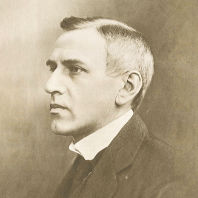Wilhelm Stenhammar
composer
During his lifetime, Wilhelm Stenhammar was considered Sweden’s best pianist and was also a much sought-after conductor. He made his breakthrough as a composer with his First Piano Concerto – not only at its premiere in Stockholm in March 1894, but also in Berlin, where he made his solo debut with the Berliner Philharmoniker performing the work in December of the same year, conducted by Richard Strauss. An event with consequences: Stenhammar dedicated the symphonic concert overture Excelsior! to the Philharmoniker, who premiered the piece in Copenhagen in September 1896 under the baton of chief conductor Arthur Nikisch to a delighted audience.
Wilhelm Stenhammar, born in 1871, received a thorough musical education in his home town of Stockholm, where his teachers included Richard Andersson, a pupil of Clara Schumann. In 1892, he made his debut as a concert soloist with Brahms’s Second Piano Concerto and also introduced himself to his native audience as a composer with the choral ballad I Rosengård. With the support of a state scholarship, Stenhammar perfected his piano skills in Berlin under Karl-Heinrich Barth – a pupil of Hans von Bülow and Carl Tausig – who also taught Arthur Rubinstein. He then began his career as a concert soloist and chamber musician. After his memorable breakthrough concert in Stockholm, he performed in Berlin, Dresden, Leipzig and Manchester under conductors such as Richard Strauss, Karl Muck and Hans Richter. In addition to his solo career, Stenhammar conducted the Stockholm Philharmonic Orchestra, the Royal Opera Orchestra, the New Philharmonic Society and the Gothenburg Orchestra Association, among others, premiering many contemporary works by Mahler, Reger, Strauss and Debussy in Sweden. In 1924, the conductor was appointed to the Stockholm Opera, but had to resign just one year later for health reasons. Held in high regard, Wilhelm Stenhammar died in Stockholm in 1927.